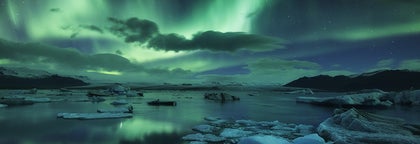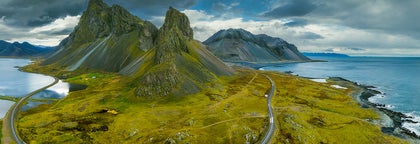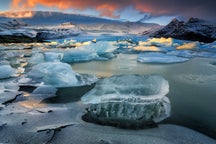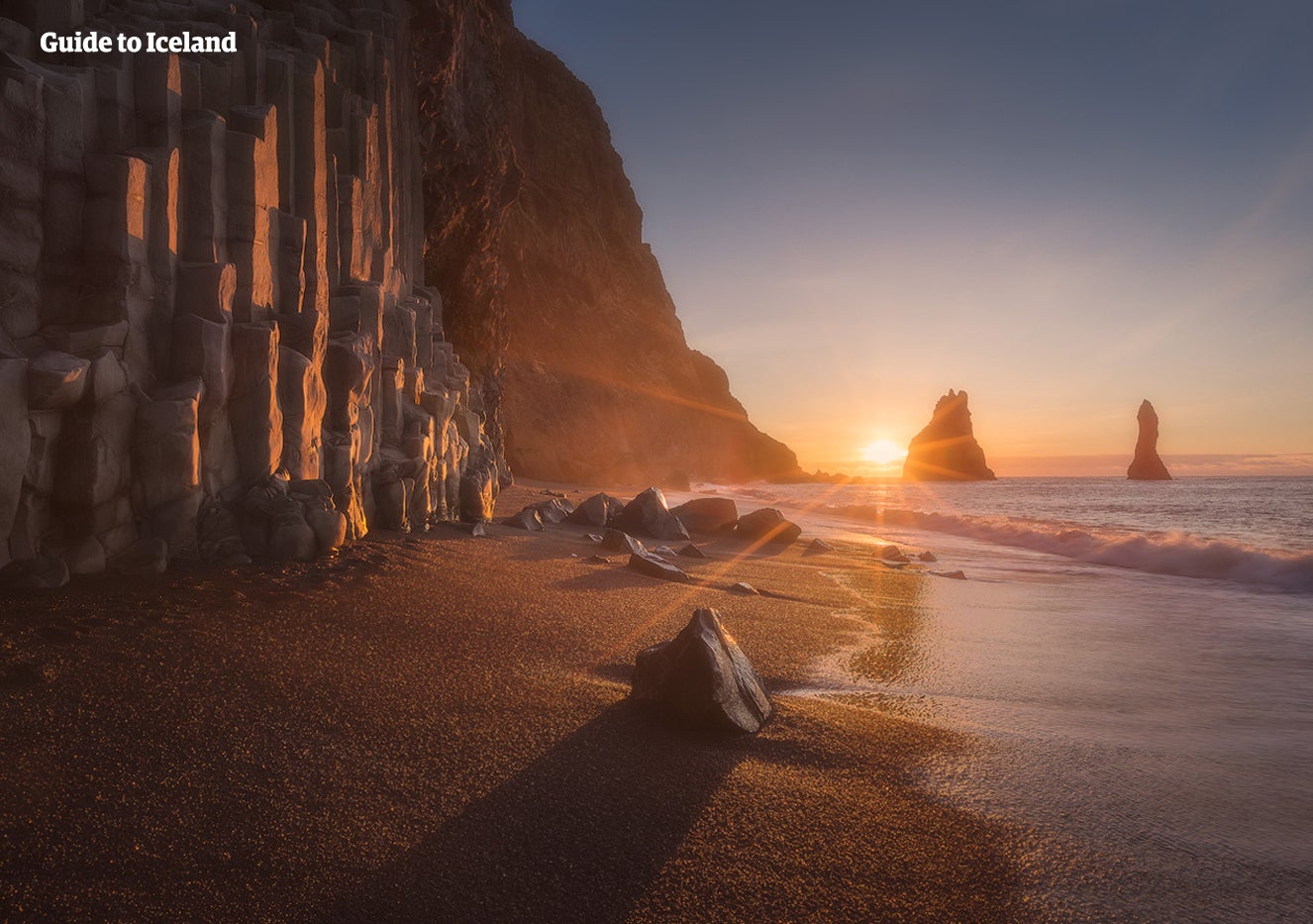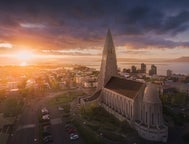
アイスランドのおすすめ氷の洞窟ツアー
アイスランドの氷の洞窟ツアー掲載数最多。氷河の中の美しい青色と模様が作り出す息を呑むような世界を体験しませんか。
ユニークな体験を見つける
出発地を選択
日付を選択
出発日最終日
人数
1名
Not sure where to start? Check out our guide to Ice Caves in Iceland
氷の洞窟ツアー
フィルターを設定すると絞り込み検索ができます
並べ替え: 人気
アイスランドをもっと楽しむ
アイスランドの旅行パッケージや現地ツアーをたくさん取り揃えました
よくある質問
今年一番の氷の洞窟ツアーは?
今シーズンは、ツアーで訪れることができる氷の洞窟が、ヴァトナヨークトル氷河の西と東にあります。
この氷の洞窟ツアーでは、その日にアクセスしやすい最高の洞窟へ向かいます。静寂に包まれた西の氷の洞窟か、印象的な東の氷の洞窟か。どちらでも素晴らしい体験ができます。
美しいブルーに輝く壁面が印象的な西の氷の洞窟では、まるで巨大なダイヤモンドの中にいるような神秘的な空間を体験できます。静かな場所なので、息をのむような美しい写真撮影にぴったりです。
一方、比較的アクセスがしやすい東の氷の洞窟は、鮮やかな色彩と迫力ある氷の造形が一生の思い出になることでしょう。
どちらの洞窟も、アイスランドの氷河がつくり出す自然の驚異を間近で感じられる素晴らしい洞窟です。
アイスランドで一番安い氷の洞窟ツアーはどれですか?
アイスランドで一番安い氷の洞窟ツアーは約150ドルです。4時間の少人数ツアーで、スカフタフェットル自然保護区(Skaftafell)のビジターセンターに集合後、ヴァトナヨークトル氷河(Vatnajokull)の氷の洞窟に向かいます。氷の洞窟探検と氷河ハイキングの両方を体験できてお得です。レイキャビクから集合場所のビジターセンターまでは車で4時間ほどの道のりです。
レイキャビク発の氷の洞窟ツアーでおすすめは?
レイキャビク発の氷の洞窟ツアーには、印象的な黒い氷で知られるヴィーク近郊のカトラ火山の氷の洞窟ツアーと、氷河の中にある人工のトンネルが象徴的なラングヨークトルの氷のトンネルツアーがあります。 どちらもレイキャビクからの送迎付きでガイド付き体験ができます。 冒険を満喫するなら、氷の洞窟とゴールデンサークルや南海岸の見どころを組み合わせた3日間のツアーに参加しましょう。
アイスランドで一番人気の氷の洞窟ツアーはどれですか?
アイスランドで一番人気の日帰りアイスケーブ・ツアーはヨークルスアゥルロゥン氷河湖(Jokulsarlon)からスーパーブルーを見に行くものです。泊りがけのツアーでは、氷河湖発の1泊2日氷の洞窟ツアーや、ゴールデンサークルも訪れる2泊3日の南海岸ツアー(氷の洞窟探検付き)が人気です。
氷の洞窟探検付きパッケージツアーで一番人気なのもやはりヴァトナヨークトル国立公園のスーパーブルーを訪れるツアーで、南海岸とゴールデンサークル観光、ブルーラグーン温泉での入浴も楽しめます。
アイスランドでは夏も氷の洞窟を見られますか?
はい、アイスランドでは夏の間、カトラ火山の氷の洞窟やラングヨークトル氷河の氷のトンネルを訪れることができます。 しかし、他のほとんどの氷の洞窟は、氷が最も安定している冬にしか行くことができなません。
10月下旬でも見られる氷の洞窟はありますか?
アイスランドの氷の洞窟は10月下旬にオープンするものもありますが、その年の天候に左右されます。 ただし、カトラ火山の氷の洞窟は一年中見学が可能です。
氷の洞窟ツアーはクリスマスシーズンでも催行されていますか?
ヴァトナヨークトル氷河のスーパーブルーを訪れる氷の洞窟ツアーはクリスマスシーズンも含め、10月から3月まで催行されています。ほとんどのツアー会社はクリスマスや祝祭日もツアーを実施しています。
スノーモービル体験と氷の洞窟見学がセットになったツアーはありますか?
はい、アイスランドにはスノーモービル体験と氷の洞窟見学が両方楽しめるツアーもいくつかあります。
アイスランドには氷の洞窟の写真撮影ツアーはありますか?
はい、写真撮影ツアーも提供しています。例えば、この少人数制の3時間の氷の洞窟ツアーには、プロの写真撮影パッケージが付いています。
アイスランドの氷の洞窟にプライベート・ツアーはありますか?
プライベートの氷の洞窟ツアーもご用意しています。この冬季限定|5時間プライベート氷の洞窟ツアーなど、お客様一人一人のご希望やご要望に合わせた、よりパーソナルな体験をお楽しみいただけます。
シニアでも氷の洞窟ツアーに参加できますか?
氷の洞窟ツアーは、シニアの方にも楽しんでいただけます。ツアーによって体力レベルや難易度が異なり、平坦な道を少し歩くだけの比較的楽なコースから、本格的なハイキングや登山が必要なコースまでございます。特にシニアの方には、レイキャビクを出発点とするフロインフォッサルの滝と氷河の洞窟ツアーがおすすめです。
アイスランドの氷の洞窟ツアーは子供も参加できますか?
アイスランドの多くの氷の洞窟ツアーは家族向けですが、年齢制限はツアーによって異なります。 安全上の理由から、ツアーによっては一定の年齢以上の子供しか参加できない場合もあるので、各ツアーの最低年齢を確認をお忘れなく。 お子様連れのご家族におすすめの氷の洞窟ツアーは、年齢制限のない定番のラングヨークトル氷河のアイストンネルツアーです。
アイスランドでクリスタルブルーの氷の洞窟が見られる場所は?
アイスランドのヴァトナヨークトル氷河の下に広がるクリスタルブルーの氷の洞窟へは、ヨークルスアゥルロゥン氷河湖から大人気のこちらのガイド付きツアーでご案内しています。2024-2025年の冬季シーズンは、広大なヴァトナヨークトル氷河の西と東にある氷の洞窟の中から、その時に最も美しい状態の洞窟へとご案内いたします。
アイスランドの氷の洞窟ツアーと氷河の洞窟ツアーの違いは?
アイスランドの氷の洞窟ツアーと氷河の氷の洞窟ツアーは、どちらもユニークな体験ができますが、それぞれ大きな違いがあります。
- 氷の洞窟ツアーは、氷河の中にある天然の洞窟に焦点を当てています。 溶けた氷が再び凍ることでできる見事な青い氷が特徴です。氷の洞窟ツアーは、氷が安定している冬に催行されるのが一般的で、ヴィーク近郊のヴァトナヨークトル氷河や、一年中見学可能なのカトラ火山の氷の洞窟などが人気です。
- 氷河の氷の洞窟ツアーには、天然の氷の洞窟と、一年通して見学できるラングヨークトル氷河の氷のトンネルのような人工の洞窟の両方が含まれます。
主な違いは、氷の洞窟ツアーは季節限定で天然洞窟であることが多いのに対し、氷河の氷の洞窟ツアーは通年で訪れることができ、人工の洞窟が含まれることもある点です。 どちらのタイプのツアーも、アイスランドの氷の驚異を探検するユニークなものです。
アイスランドの氷の洞窟を訪れるベストシーズンは?
氷の洞窟ツアーは、氷が最も安定する11月から3月がベストシーズンです。ヴァトナヨークトル氷河の素晴らしいクリスタルブルーの洞窟を訪れるツアーも、その時期限定となっています。一方で、ラングヨークトル氷河やカトラ火山の氷の洞窟は、人工的な造りや特殊な地質条件により、一年を通して見学いただけます。
アイスランドの氷の洞窟を個人で訪れることはできますか?
いいえ、できません。プロのガイドなしで氷の洞窟に入るのは非常に危険ですので、絶対におやめください。
アイスランドの氷の洞窟ツアーの所要時間は?
アイスランドの氷の洞窟ツアーは4~5時間くらいのものが多いです。氷の洞窟の中で過ごす時間は45~60分程度ですが、装備の貸出や氷の洞窟までの氷河ハイキングなどに時間がかかるためです。
アイスランドの氷の洞窟・アイスケーブはどうやってできるのですか?
アイスランドの氷の洞窟は、夏になると氷河の割れ目から流れ込んだ雪解け水が、新たな流れ道を作ることで形成されます。そのため、氷の洞窟が安定する冬の時期にしかツアーが催行されないことがほとんどです。
アイスランドの氷の洞窟はどこにあるのですか?
アイスランドの氷の洞窟は島内各地にあるのですが、最も観光客に人気なのは「スーパーブルー」と呼ばれるヴァトナヨークトル国立公園(ヨークルスアゥルロゥン氷河湖の近く)のアイスケーブです。この他、ゴールデンサークルのそばにあるラングヨークトル氷河や、南部の町ヴィークに近いカトラ・アイスケーブ(通年見学可)などがあります。
アイスランドの氷の洞窟は行った方がいいですか?
もちろんです。アイスランドの氷の洞窟を訪れることは、まるで別世界へと足を踏み入れるような、忘れられない体験となるでしょう。素晴らしい写真スポットが数多くあり、特に冬季限定の氷の洞窟では、より貴重な思い出を作ることができます。
氷の洞窟には安全に入れますか?
はい、アイスランドの氷の洞窟は、経験豊富な氷河ガイドや専門家が定期的に安定性をチェックしているため、安全に訪れることができます。 中に入ることができるのは、訓練を受けた専門家によるガイド付きの氷の洞窟ツアーだけです。
アイスランドの氷の洞窟のベストシーズンは?
アイスランドの氷の洞窟のベストシーズンは11月から翌3月までの冬の間です。この時期は気温が低いため、氷が溶ける心配が少なく、アイスケーブを見学できる可能性が高いです。
氷の洞窟ツアーでは、洞窟内にいる時間はどのくらいですか?
アイスランドの氷の洞窟ツアーのほとんどが、洞窟の中で40~50分ほどかけて、氷河の壁や氷の造形について学びながら見学します。
アイスランドの氷の洞窟はどのくらい寒いのですか?
アイスランドの氷の洞窟の内部の気温は0℃くらいです。寒いとマイナス10℃くらいになることもあります。防寒対策をしっかりし、ニット帽も忘れずにお持ちください。夏のアイスケーブ見学でも同様です。
氷の洞窟の中ではどんな氷の造形が見られるのですか?
アイスランドの氷河の洞窟の中では、つらら、氷滝、青や白、黒(火山灰)の氷の層などが見られます。洞窟の場所や見学の時期によっても違うので、どうぞお楽しみに。
アイスランドの氷の洞窟は毎年同じように見えるのですか?
アイスランドの氷の洞窟の多くは、融解と再凍結を繰り返すことで毎年その姿を変える自然の芸術作品です。そのため、同じ氷河を訪れても、その時々で異なる表情を見せてくれます。ただし、ラングヨークトル氷河の氷のトンネルなどは人工的に作られているため、年間を通して同じような景観を楽しむことができます。
真冬の早朝に氷の洞窟を訪れて、太陽の光はあるのでしょうか?
レイキャビクから氷の洞窟までは4~5時間かかります。 到着して装備を整えている間に日が昇り、洞窟探検を始める準備が整います。
氷の洞窟ツアー参加時は、どのような服装をしたらいいですか?
アイスランドの氷の洞窟ツアーでは、保温性の高いベースレイヤー、保温性の高いジャケット、グリップ力のある頑丈な防水ブーツなど、暖かく防水性の高い服装が不可欠です。 洞窟内は寒く滑りやすいので、手袋、帽子、マフラーの持参もおすすめします。
アイスランドの氷の洞窟ツアーでは特別な装備が必要ですか?
いいえ、ツアー詳細に明記されていない限り、アイスランドの氷の洞窟ツアーでは特別な装備は必要ありません。アイスクライミングがセットになったツアーなどでは、ツアー詳細にその旨が明記されています。こうした場合でもクライミング装備は貸出を受けられる場合がほとんどです。
アイスランドの氷の洞窟ツアーは体力的にきついものですか?
アイスランドの氷の洞窟ツアーで求められる体力はさまざまです。 氷河ハイキングが必要な洞窟もあれば、短い距離を歩くだけの洞窟もあります。 ツアーに必要な体力レベルについては、各ツアーの説明をご確認ください。
氷の洞窟ツアーを選ぶポイントは?
氷の洞窟ツアーはツアーの難易度、所要時間、ロケーション、グループの人数などである程度絞り込めます。その上で旅行時期や好み、体力、他の予定を考慮して選ぶとよいでしょう。
氷の洞窟ツアーは悪天候でも催行されますか?
氷の洞窟ツアーは悪天候等、ツアー運営会社が危険と判断した場合には中止または別日に変更されることがあります。中止の場合、また変更後の日時で参加できない場合はツアー代金は全額返金されます。
アイスランドの氷の洞窟の見学方法は?
アイスランドの氷の洞窟を訪れるには、ガイド付きツアーに参加します。ガイドは氷河や洞窟、現地の状況に詳しく、参加者の安全を確保するだけでなく、氷の洞窟やその形成について教えてくれます。
アイスランドの氷の洞窟は写真撮影自由ですか?
はい、アイスランドの氷の洞窟では自由に写真を撮ってOKです。とても珍しく美しい写真が撮れるので是非チャレンジしてみてください。暗い場所でも撮影できるカメラがあるとよいでしょう。また、安全と自然保護のため、現地では必ずガイドの指示に従ってください。
氷の洞窟をドローンで撮影できますか?
アイスランドの大自然の中ではドローン撮影は制限・禁止されている場所が多いです。氷の洞窟やその周辺でも、安全上の問題や野生動物・環境への影響から、ドローンを使えないところがほとんどです。ドローンの使用については必ずツアーガイドに確認し、地元のルールを守ってください。
アイスランドの氷の洞窟ツアーは事前予約した方がいいですか?
はい。氷の洞窟ツアーは、特に冬のピークシーズンは人気が高く、すぐに満席となってしまいます。確実にツアーに参加できるよう、また余裕を持って旅行計画が立てられるよう、事前のご予約を強くおすすめいたします。
氷の洞窟探検と他のアクティビティがセットになったツアーはありますか?
はい、アイスランドには氷の洞窟探検と氷河ハイキング、スノーモービル、オーロラハンティングなどの人気アクティビティがセットになったツアーもあります。これらのパッケージをご利用いただくと、アイスランドの様々な見どころを、よりお得に、より便利に、そして手軽にお楽しみいただけます。
氷の洞窟にはトイレはありますか?
ツアー中は、氷の洞窟内やその周辺でのトイレ使用が難しい、もしくはできない場合がほとんどです。そのため、氷河装備に着替えるベース施設や、近くの設備でトイレを済ませてからツアーに参加されることをおすすめします。
氷の洞窟ツアーの定員は何人ですか?
アイスランドの氷の洞窟ツアーの最大参加人数は、運営会社や訪れる洞窟によって違います。定員が8名の場合もあれば、20名以上参加できるツアーもあります。
氷の洞窟は車いすでも入れますか?
アイスランドの氷の洞窟内は、起伏の多い地形で、狭い通路の通過や登りが必要な場所もあるため、残念ながら車椅子でのアクセスは難しい状況です。
バリアフリー対応についてご不安な点がございましたら、info@guidetoiceland.isまでお気軽にご相談ください。可能な限り、代替プランや対応可能な宿泊施設などをご案内させていただきます。

アイスランド最大の旅行アプリをインストール
アイスランド最大の旅行アプリをスマートフォンにダウンロード。旅のすべてを1か所で管理できます。
アイスランド最大の旅行マーケットプレイスをポケットに。スマートフォンのカメラでQRコードを読み取り、表示されるリンクをクリックしてください。電話番号またはメールアドレスを入力すれば、SMSやEメールでもダウンロードリンクを受け取ることができます。

























